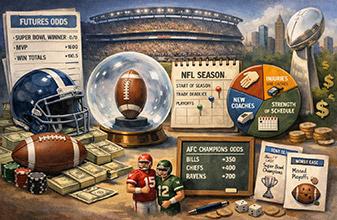Betting on NFL Totals

Sharp Sports Betting is a tool for those interested in winning money at sports betting. The book explains the most common sports bets, what all the numbers mean, and the mathematics behind the numbers.
All prospective bettors should know the basic principles of sports betting. You should not be betting online or in Las Vegas, Atlantic City, or elsewhere without this fundamental knowledge.
On NFL games, you can bet on more than just which team will win; you also can bet on how many points the two teams will score. The sportsbook posts an estimate of how many points it thinks will be scored; that number is called the total. You can bet that the sum of the points of both teams will be greater than the total; that bet is called the over. And you can bet that the points scored by both teams will be less than the total; that bet is called the under.
Generally there is a minimum number of minutes that must be played for totals to have action; if the game is called early for whatever reason, all money wagered on totals is returned to the bettors.
Points scored in overtime count for deciding over and under bets.
If the sum of the final scores falls right on the total, there is no money won or lost; you turn in your ticket and get your money back.
If you are capable of making or finding a good line on a game, you might be able to find a good bet on a total. Totals have the reputation of being easier to beat than sides.
Totals of Totals
Some totals are more common than others -- 37 is the most common total. About 5% of NFL games end with a total of 37. The next most common total is 41. The ranking of the other totals depends on how many years of data you decide to use.
Some totals are rarer than others. The rarest totals in the range 30-59 are 56 and 32. One percent of game totals land on exactly 32, and a total of 56 is rarer yet.
Pushes on Totals
About five percent of overall games end with a total of 37, and about five percent of games predicted to produce 35 to 39 points actually produce exactly 37 points. This is a bit surprising; you might have thought that games expected to produce around 37 points would be more likely to produce exactly 37 points than games expected to be lower scoring or higher scoring.
So how big a deviation between your prediction and the posted O/U number do you need to overcome the book’s vig, assuming your prediction is accurate? You need to gain 4.55 percent, the same as if you were picking a side, because you pay the same $110 to try to win $100. You can estimate the point at which you have an edge; you must pick up at least five percentage points to overcome the book’s vig.
As an example, if the true line on the total is 37, you can break even by betting under 37.5 or over 36.5. For other numbers, you generally need one full point to break even or get a small edge. For example, if the true line on the total is 44.5, you can overcome the book’s vig betting under 45.5. The only important exception is 39; if the 39 is involved, you need 1.5 points to break even.
Generally you need a gap of two points to at least break even on a middle on totals. You need five percent per bet to break even. For example, betting equal amounts over 43.5 and under 45.5 picks up fourteen percent, which is better than breaking even. If you can find a wider spread than two points, you have found a profitable middle.
This is part of an occasional series of articles.
Excerpted with permission from Sharp Sports Betting by Stanford Wong, edited for this format.











Please log in or register to leave a comment